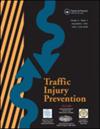Comparative analysis of injury identification using KABCO and ISS in linked North Carolina trauma registry and crash data
IF 1.6
3区 工程技术
Q3 PUBLIC, ENVIRONMENTAL & OCCUPATIONAL HEALTH
引用次数: 0
Abstract
Objective
The purpose of this study was to examine differences between police-reported injury severity and trauma registry data among persons with linked records in North Carolina and quantify the degree of alignment.
Methods
We analyzed linked North Carolina trauma registry and motor vehicle crash data from 2018. Injury severity identification was assessed using police-reported 5-point scale KABCO from crash data and Injury Severity Score (ISS) from trauma records. The analysis was stratified by age, sex/gender, race, ethnicity, and road users type to examine differences across groups. We calculated sensitivity, specificity, positive predictive values, and negative predictive values between police-reported injury severity and trauma registry data using ISS as the gold standard.
Results
A higher proportion of patients were classified as suspected minor injuries (39.0%) compared to moderate injuries in trauma registry (25.1%). Police-reported crash data underreported injury severity when compared to trauma registry data. Police-reported KABCO had a higher degree of specificity when classifying minor injuries (79.3%) but substantially underestimated seriously injured patients, with a sensitivity of 49.9%. These findings were also consistent when stratified by subpopulations.
Conclusion
Hospital-based motor vehicle crash data are a main source of injury severity identification for road safety. Police-reported data were relatively accurate for minor injuries but not seriously injured patients. Understanding the characteristics of each data source both separately and linked will be critical for problem identification and program development to move toward a safe transportation system for all road users.
使用 KABCO 和 ISS 对北卡罗来纳州创伤登记和车祸数据进行比较分析。
目的:本研究的目的是检查北卡罗来纳州有关联记录的人员中警方报告的受伤严重程度与创伤登记数据之间的差异,并量化两者之间的一致程度:本研究旨在研究北卡罗来纳州有关联记录的人员中,警方报告的受伤严重程度与创伤登记数据之间的差异,并量化两者的一致程度:我们分析了 2018 年关联的北卡罗来纳州创伤登记和机动车碰撞数据。使用车祸数据中警方报告的 5 点量表 KABCO 和创伤记录中的伤害严重程度评分 (ISS) 评估伤害严重程度鉴定。分析按照年龄、性别、种族、民族和道路使用者类型进行分层,以检查不同群体之间的差异。我们以 ISS 为金标准,计算了警方报告的受伤严重程度与创伤登记数据之间的敏感性、特异性、阳性预测值和阴性预测值:与创伤登记中心的中度伤害(25.1%)相比,被归类为疑似轻度伤害的患者比例更高(39.0%)。与创伤登记数据相比,警方报告的车祸数据低报了受伤严重程度。警方报告的 KABCO 在对轻伤进行分类时具有较高的特异性(79.3%),但却严重低估了重伤患者,灵敏度仅为 49.9%。这些结果在按亚人群分层时也是一致的:结论:以医院为基础的机动车碰撞事故数据是道路安全受伤严重程度鉴定的主要来源。警方报告的数据对轻伤患者相对准确,但对重伤患者则不准确。了解每种数据源的特点,无论是单独数据源还是关联数据源,对于问题识别和项目开发都至关重要,从而为所有道路使用者打造一个安全的交通系统。
本文章由计算机程序翻译,如有差异,请以英文原文为准。
求助全文
约1分钟内获得全文
求助全文
来源期刊

Traffic Injury Prevention
PUBLIC, ENVIRONMENTAL & OCCUPATIONAL HEALTH-
CiteScore
3.60
自引率
10.00%
发文量
137
审稿时长
3 months
期刊介绍:
The purpose of Traffic Injury Prevention is to bridge the disciplines of medicine, engineering, public health and traffic safety in order to foster the science of traffic injury prevention. The archival journal focuses on research, interventions and evaluations within the areas of traffic safety, crash causation, injury prevention and treatment.
General topics within the journal''s scope are driver behavior, road infrastructure, emerging crash avoidance technologies, crash and injury epidemiology, alcohol and drugs, impact injury biomechanics, vehicle crashworthiness, occupant restraints, pedestrian safety, evaluation of interventions, economic consequences and emergency and clinical care with specific application to traffic injury prevention. The journal includes full length papers, review articles, case studies, brief technical notes and commentaries.
 求助内容:
求助内容: 应助结果提醒方式:
应助结果提醒方式:


